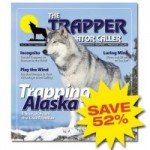By Serge Lariviére
This is going to be one tough season, and if you have not yet started to complain about fur prices, do not worry, you will get lots of opportunities. We are simply in one of the worst slumps in the market that this industry has ever seen. Two international auctions sales were just completed, Fur Harvesters and NAFA’s, and none were good. Yes, you can say that auctions are not the only place to sell fur but what happens at auctions set the trends for fur sales elsewhere. A lot of local buyers watch international auctions to set their own prices and even the largest country buyers many times have the same network of clients, at least in part, as those that attend auction sales. There is no hidden secret in this trade—the big buyers are well known by everyone. And big buyers usually attend all sales, in addition to doing some business with some of the largest private buyers. So there is no magic bullet, no special fur clientele that is known only to this or that buyer: everyone in this trade knows everyone that is active. And if something sells well, everyone is aware and all try to get involve for their fair share. But when the market hits a low spot, trappers have limited options.
market overview
First, there were no surprises. We know the Russians are out right now because their money, the Russian ruble, has lost strength because of the drop in oil prices and the economic sanctions. Then, most parts of the world were hit with warmer than average fall temperatures (El Nino effect) and this is certainly a factor we have seen in North America, but warm temperature in core markets always hurt retail sales, which in turn reduces the cash available for the manufacturers to buy new raw skins for next year. Except for the warm weather, we knew it was going to be tough before we even started.
noted from NAFA:
In a press release from February this year, NAFA communicated the following, which summarizes well what happened at their first sale:
“As we had previously indicated, we were faced with exceptionally difficult challenges going into our first auction, including:
– The sudden, dramatic fall in prices in September, which created huge capital losses across the industry.
– Unseasonably warm weather in December in many of the important markets across the globe.
– Political unrest in Russia, and the Ruble suffering to less than half of its value from early last year, effectively flattening the consumer market in that country.
– The instability in the global stock markets, including in China, and the financial unease that continues to follow.”
Ranch Mink has Peaked?
Many auctioneers now think that the world production of ranch mink may now have reached what the world can consume annually. As you know, China still buys a tremendous amount of fur, but mainly ranch fur.
The negative impact of ranch mink on wild fur prices occurs mainly when ranch mink prices slump. Ranch mink being easier and cheaper to tan, when buyers have the choice for the same price of getting ranch mink instead of raccoon, they buy cheap mink. And prestige is still there: cheap mink still is mink, and a mink coat is much more prestigious than a raccoon coat. In parts of China right now, some mink coats sell for $450-600 apiece because of the low mink prices, inventory overload, and cash flow issues. Such prices make it impossible for wild fur to compete, especially for raccoons, where the dressing itself cost more than what the fur is worth.
The Top 3 Furs
Where is the hope now? I would say three fur species remain decent on today’s market: western coyotes, female fisher, and marten. Globally, fur marketers worldwide still work hard to help European manufacturers launch new lines of wild fur garments that will set the fashion trends. This is another complexity of this market: Europe and North America are not a big user of wild fur, but the fashion designers of major cities both overseas and here set the trends, and once a trend is established and something starts to sell well, China comes in and copies it. When 80 percent of the world fur is purchased in China, we have to do whatever it takes to get our fur in the Chinese stores. South Korea is increasing its participation in the fur industry also, and Koreans like quality so maybe this will help us trappers in the future.
The international sales that just occurred are the first of the year, and granted, not all species of wild fur were offered, and a lot of the offering were skins unsold from last year. The biggest wild fur sales of 2016 will occur in mid-March for Fur Harvesters Auctions, and early April for North American Fur Auctions. That is really when we will have the final and definite pulse of the industry for this year. But you need not worry: if you have not yet had a chance to complain about fur prices, we may not have seen the worst of it yet.
This is the Fur Market Report from the March 2016 issue of Trapper & Predator Caller magazine.
You can pick up a copy of the digital issue on www.ShopDeerHunting.com.
Subscribe to Trapper & Predator Caller Magazine
 Trapper & Predator Caller is the best trapping and predator hunting magazine. Why aren’t you a subscriber? Sign up today and receive furbearer news, trapping techniques, fur market reports and more right to your mailbox.
Trapper & Predator Caller is the best trapping and predator hunting magazine. Why aren’t you a subscriber? Sign up today and receive furbearer news, trapping techniques, fur market reports and more right to your mailbox.
